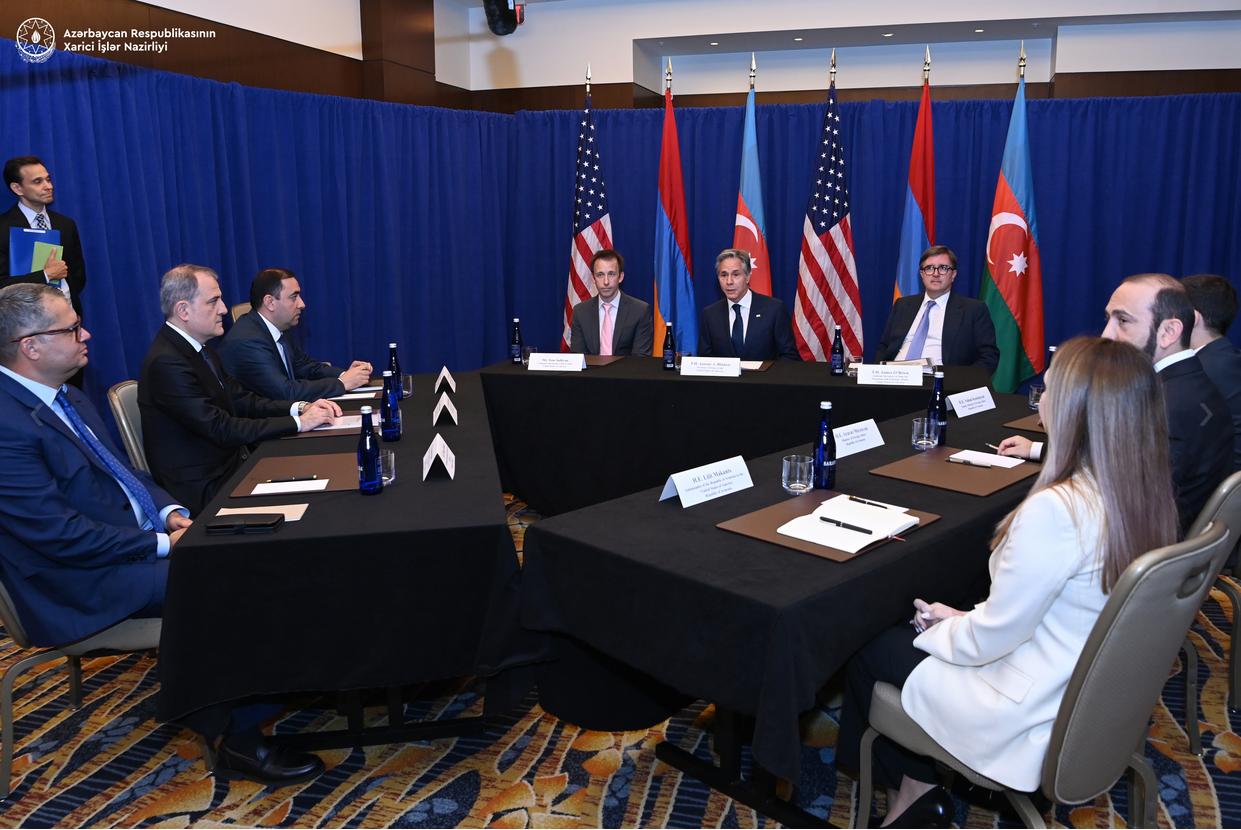Azerbaijan-Armenia: Three gradations of accord: Where are we now? Contemplations with Orkhan Amashov/VIDEO
In the latest episode of 'Contemplations', Orkhan Amashov looks into what could be concluded in the shape of an agreement between Azerbaijan and Armenia at this precise juncture, and why it is important to woe betide those advocating the idea of signing some agreement solely for the sake of doing so.
At a time when the US is ostensibly pushing for some written accord between Azerbaijan and Armenia, with Pashinyan and Co regularly claiming such a deal is indeed achievable within a month’s time, and Baku conversely arguing that any peace treaty will be impossible without Armenia changing its constitution, one wonders as to what one should make of the current landscape enveloping the negotiations.
First and foremost, it behoves one to understand what sort of a deal Baku and Yerevan could realistically finalise in the near future - prior to COP29 - which the US and others have been at pains to promote as an unofficial deadline. We also need to reflect on how consequential and comprehensive such a document could or should be, and whether it may be construed in such a way that would fit the bill, namely becoming a substantial accord, laying the true foundations of further normalisation between the parties involved and leading to a long-term, durable peace in the region.
Let us consider three different scenarios:
A framework document, worked out as a compilation of lofty aspirational principles, mentioning the mutual recognition of territorial integrity and sovereignty and other basic elements of interstate normalisation, is indeed a possibility. In fact, the extended and elaborated version of the five principles, presented by Azerbaijan back in March 2022, on the bones of which some flesh was subsequently accorded via bilateral exchanges, may indeed constitute its essence.
Such a deal will not touch upon specifics, omitting most central questions, engendering some positivity, and perhaps attracting a few bombastic headlines. In view of its vague content, the option in question would give rise to “constructive ambiguity”, providing a framework for Baku and Yerevan to argue on the semantics pertaining to the precepts entailed within the text. Under no circumstances could this be seen as an effective counterpoise against the possibility of the renewal of active military confrontation.
But still… The Americans and Europeans would love to see something signed along these lines, for which the Biden administration would take some credit. The rationale here is to be understood in the context of the current sense of urgency guiding Blinken’s efforts to coerce the parties into signing some accord before the Presidential elections to be held in the US this November, where Armenian-Americans are likely to be active and vocal.

Armenia will, of course, embrace such a deal, for Pashinyan is likely to feel more secure, both internally and vis-à-vis Baku, possibly endeavouring to capitalise on the vagueness of the text as a shield against any substantial demands that may subsequently emanate from Baku. Azerbaijan, on the other hand, won't touch it with a bargepole, for such a deal would not address its main concern, that is, the presence of territorial claims, ingrained in the Armenian constitution, against Baku. So, by and large, all things considered, this option should be deemed as eminently ‘ditchable’ and unworthy of the paper it hasn’t yet been written on.
The second option could be viewed as a more improved version of the first, where Armenia acknowledges its constitutional problem, making a commitment to remedy this within a specified time period. The question is whether Baku will be content with this. So far, what we have heard from Azerbaijan officially suggests that without Armenia removing the “miatsum” provision from its constitution, no agreement can be deemed as viable. Plus, since we are talking about an arrangement which should exceed the mere requirement of being a “collection of generic precepts”, something more specific or substantial is required.
For instance, Baku and Yerevan have not fully agreed, so far as one can tell, on the exact principle that will guide the future delimitation and demarcation of the interstate border. Armenia favours the reference to the latest Soviet maps in line with the 1991 Alma-Aty declaration, with Azerbaijan proposing a more flexible and less restrictive approach, with the process being finalised incrementally – “stage-by-stage” - with no rigid emphasis on the very latest cartographic documentation concerning each section of the border. In all probability, the text will include one provision as to this, the construct of which remains unsettled.
The same also applies to the subject of the reopening of communications. The principles of sovereignty, equality and reciprocity, regularly referred to by the Armenian side, do not actually provide a clear answer regarding impediments to the overland passage connecting mainland Azerbaijan with its Nackhivan exclave.
Thirdly, we have to consider a proper substantive framework deal, approaching the requirements of a near-comprehensive agreement, yet falling short of its all-embracing exigencies. Such a deal will incorporate near-uniformly understood principles, the content of which will provide contours enabling the augmentation of further normalisation, encompassing a full spectrum of interstate interaction. Ideally, this could be signed after Armenia removes territorial claims towards Azerbaijan from its Constitution, in the wake of significantly tangible progress in negotiations. We are nowhere near this point.

In principle, a less ambitious variation of the second option, with a mere acknowledgement by Armenia of its constitutional problem and a written obligation to remedy this by a certain deadline, in addition to less than specific tenets as to other aspects of interstate normalisation is possible, and should by no means be deemed as eminently “ditchable”. Such an arrangement could be euphemistically referred to as a "preliminary document". Nevertheless, the question is what will be its actual purpose and utility. The signing of a deal for the sake of doing so is not a particularly plausible proposition.
Allow me to say a few words about the so-called ‘pushiness’ presently demonstrated by the US. This sense of urgency by Blinken and his team appears, as ever, to be largely self-serving. The current administration is in a hurry, trying to get the parties to conclude a written accord before a potential change in Washington DC. It is also driven by what is perceived as Armeno-centrism in Azerbaijan; in a nutshell, Baku’s demands exacerbate Pashinyan's situation, and its requirements regarding the Armenian Constitution, for all their legitimacy, should be either curbed in their forcefulness or retracted for the time being, thereby now making a deal possible.
After all, Azerbaijan and Armenia need a peace deal. It is also very clear that they need a proper peace deal, not signed as a statement for third parties or any other reason, but for the purpose of achieving a breakthrough, leading to enhanced certainty rather than lingering uncertainty that dangerously borders on 'constructive ambiguity'.








